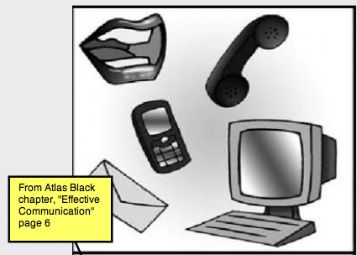Communication Forms & ADR Tasks

These days we have lots of choices for how we want to communicate with others and thinking in advance about what channel is best makes sense for conflict management experts.
In 2002 Australia's National Alternative Dispute Resolution Advisory Council (NADRAC) produced a report on principles for good practice in Dispute Resolution and Information Technology. In this report they reviewed various forms of communication in light of their potential use in alternative dispute resolution. While showing its age a bit, the summary still provides a helpful review of the benefits and limitations of different modes of communication. A table from the report is provided below. The full report is available online here.
Matching the form of communication to the task
|
Form of communication |
Requirements |
Benefits |
Limitations and risks |
Current and potential applications |
|
Face to face meeting |
Physical meeting venue and waiting room facilities Parties need to be able to travel to the venue, and be capable of face to face communication |
Allows for full 'real time' communication, verbal, non-verbal and body languages, exchange of written information, clear authentication, signing off. Creates a sense of occasion and ritual |
Negative personal dynamics, intimidation, physical violence |
The most favoured and common form for interaction |
|
Face to face meeting complemented by IT or AV |
Software and hardware |
May overcome some problems associated with face to face meeting, and give additional tools to the ADR process. |
The benefits way not be worth the expense and effort of setting such systems up |
May need to match needs of parties with specific needs and problems |
|
Letters |
Stationary and postage facilities |
Formal, authentic (signed). |
Slow. Eliminates non-verbal factors |
Formal letters of introduction, final agreements, etc |
|
|
Access to computer, Internet and ISP by parties and ADR service. (Low bandwidth) Keyboards skills and computer literacy Appropriately secure access and authentication protocols |
Enables exchange of complex written information Neutralises negative interpersonal dynamics Give people time and space to consider responses |
Conveys limited interpersonal information. Too slow to type Difficult to develop trust Asynchronous communication |
Not commonly used to conduct entire ADR process, but often used as an adjunct to face to face and telephone communication, especially for information and document exchange |
|
Automated processes (e.g. - Automated negotiation, such as blind bidding) |
As above, but keyboard skills less important |
Privacy, quick and accessible Face saving Neutralises personal dynamics. Parties' offers and demands can be totally protected and eventually deleted |
Impersonal Lacks personal engagement of an ADR practitioner Current programs may be rigid, lacking intuition |
At this stage, programs are unsophisticated and limited to simple quantitative (eg monetary) matters, that are amenable to a compromise solution. Artificial Intelligence may become more 'intuitive' over time |
|
Video or audio-streaming |
As above, although bandwidth and computing capacity requirements may be higher |
May be more effective than text in conveying messages, especially emotions |
Asynchronous communication |
Not used extensively in ADR process itself. |
|
Telephone and tele-conference |
Access to telephone lines, preferably with conference call capacity |
Availability Ease of use Immediacy of communication May reduce some negative aspects of face to face communication such as violence and intimidation |
Reliant on oral communication only; unable to exchange written information or authenticate material. |
Very commonly used, especially for information, intake and follow up. Also used to overcome geographical distance |
|
Video conference |
Availability of compatible equipment (cameras, microphones, etc.) software and high bandwidth - dependent on quality of signal required. Parties usually need to travel to appropriate video conference venue (but in longer term may be able to readily access such facilities in ordinary home or office environments |
Approximates face to face interaction, by providing for oral and visual communication. May reduce some negative aspects of face to face communication such as physical violence and intimidation (although visual and verbal intimidation is still possible) |
Aspects of communication lost or distorted through time lag, eye contact, 2-dimensional image Loss of other sensory data (smell, taste) Some technical and cost barriers (but these are declining in significance) |
Used successfully by some ADR service providers, especially to overcome geographical distance |
|
Integrated technologies |
Appropriate bandwidth, software and equipment |
Combines benefits of each of video, telephone and text. |
As for videoconferencing, some aspects of communication are lost |
Emergent technology; likely to be commonplace in the next few years. Has the potential to create a 'critical mass', increasing the acceptance and uptake of on-line communication |
|
Virtual reality |
Currently fairly stylized. Requires specialized equipment and large bandwidth |
Three-dimensional interactivity. |
For most applications The benefits not yet worth the cost and inconvenience for what is predominantly a verbal process. |
Rarely used in ADR if at all May have specialised uses, eg training, therapy, sensory-motor, non-verbal interaction, overcoming specific disabilities |
|
Holography |
Huge bandwidth Not currently feasible |
May be visually indistinguishable from face to face interaction |
Lacks physical touch |
Still in the realm of science fiction |
Source: National Alternative Dispute Resolution Advisory Council. Dispute Resolution and Information Technology. Canberra: Commonwealth of Australia, 2002.
Licensed under the Creative Commons Attribution Non-commercial No Derivatives 3.0 License
For Educational Use Only